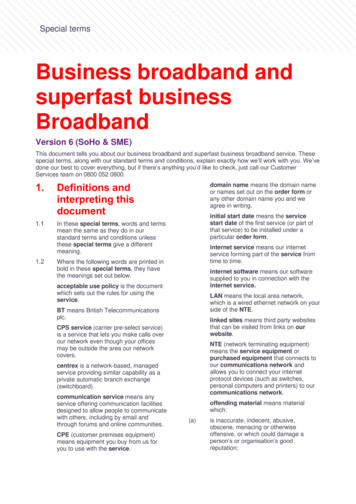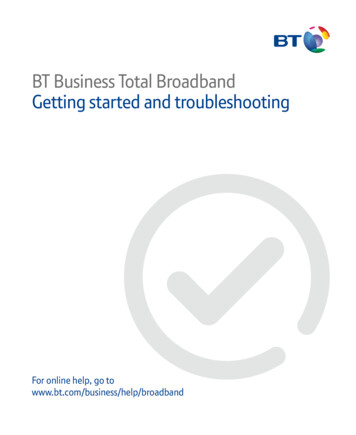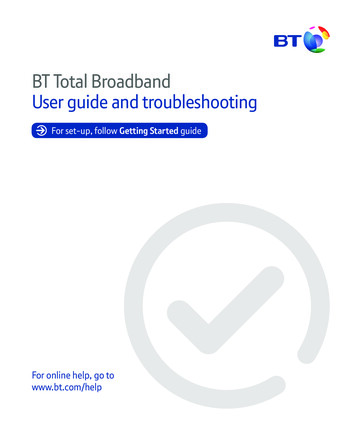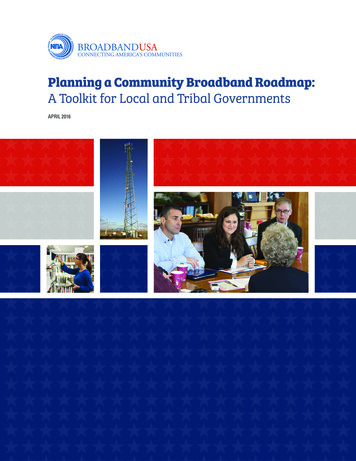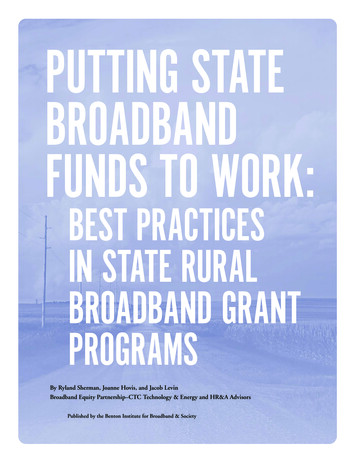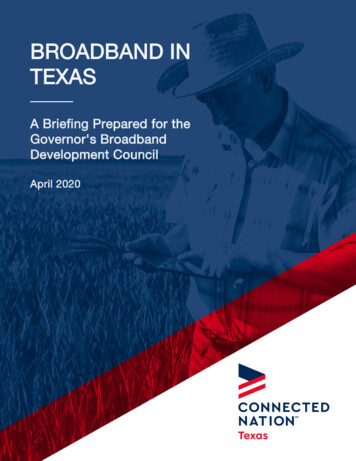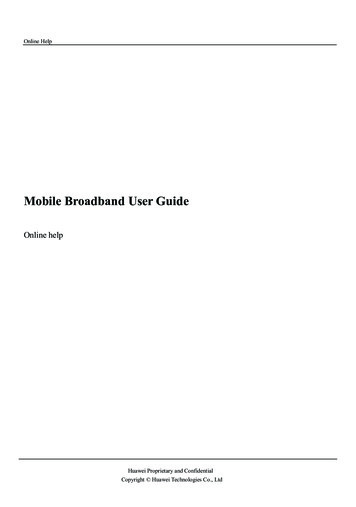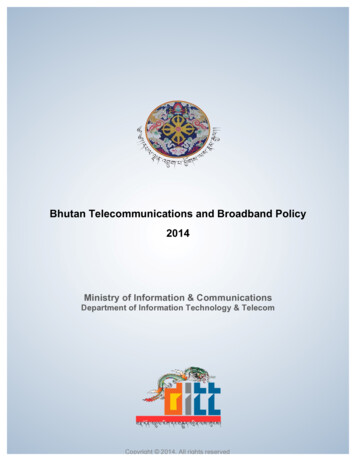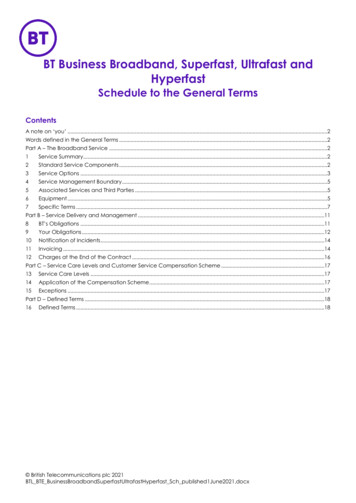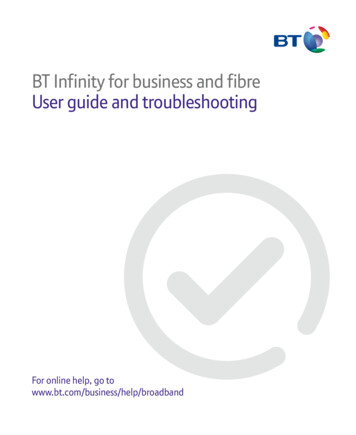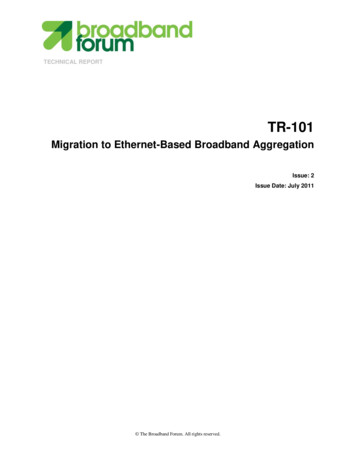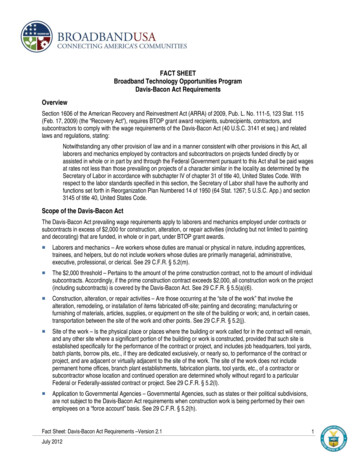
Transcription
FACT SHEETBroadband Technology Opportunities ProgramDavis-Bacon Act RequirementsOverviewSection 1606 of the American Recovery and Reinvestment Act (ARRA) of 2009, Pub. L. No. 111-5, 123 Stat. 115(Feb. 17, 2009) (the “Recovery Act”), requires BTOP grant award recipients, subrecipients, contractors, andsubcontractors to comply with the wage requirements of the Davis-Bacon Act (40 U.S.C. 3141 et seq.) and relatedlaws and regulations, stating:Notwithstanding any other provision of law and in a manner consistent with other provisions in this Act, alllaborers and mechanics employed by contractors and subcontractors on projects funded directly by orassisted in whole or in part by and through the Federal Government pursuant to this Act shall be paid wagesat rates not less than those prevailing on projects of a character similar in the locality as determined by theSecretary of Labor in accordance with subchapter IV of chapter 31 of title 40, United States Code. Withrespect to the labor standards specified in this section, the Secretary of Labor shall have the authority andfunctions set forth in Reorganization Plan Numbered 14 of 1950 (64 Stat. 1267; 5 U.S.C. App.) and section3145 of title 40, United States Code.Scope of the Davis-Bacon ActThe Davis-Bacon Act prevailing wage requirements apply to laborers and mechanics employed under contracts orsubcontracts in excess of 2,000 for construction, alteration, or repair activities (including but not limited to paintingand decorating) that are funded, in whole or in part, under BTOP grant awards. Laborers and mechanics – Are workers whose duties are manual or physical in nature, including apprentices,trainees, and helpers, but do not include workers whose duties are primarily managerial, administrative,executive, professional, or clerical. See 29 C.F.R. § 5.2(m). The 2,000 threshold – Pertains to the amount of the prime construction contract, not to the amount of individualsubcontracts. Accordingly, if the prime construction contract exceeds 2,000, all construction work on the project(including subcontracts) is covered by the Davis-Bacon Act. See 29 C.F.R. § 5.5(a)(6). Construction, alteration, or repair activities – Are those occurring at the “site of the work” that involve thealteration, remodeling, or installation of items fabricated off-site; painting and decorating; manufacturing orfurnishing of materials, articles, supplies, or equipment on the site of the building or work; and, in certain cases,transportation between the site of the work and other points. See 29 C.F.R. § 5.2(j). Site of the work – Is the physical place or places where the building or work called for in the contract will remain,and any other site where a significant portion of the building or work is constructed, provided that such site isestablished specifically for the performance of the contract or project, and includes job headquarters, tool yards,batch plants, borrow pits, etc., if they are dedicated exclusively, or nearly so, to performance of the contract orproject, and are adjacent or virtually adjacent to the site of the work. The site of the work does not includepermanent home offices, branch plant establishments, fabrication plants, tool yards, etc., of a contractor orsubcontractor whose location and continued operation are determined wholly without regard to a particularFederal or Federally-assisted contract or project. See 29 C.F.R. § 5.2(l). Application to Governmental Agencies – Governmental Agencies, such as states or their political subdivisions,are not subject to the Davis-Bacon Act requirements when construction work is being performed by their ownemployees on a “force account” basis. See 29 C.F.R. § 5.2(h).Fact Sheet: Davis-Bacon Act Requirements –Version 2.1July 20121
Davis-Bacon Act prevailing wage requirements are likely to apply to construction and related activities undertaken inconnection with Infrastructure Round 1 and Comprehensive Community Infrastructure (CCI) Round 2 projects(together referred to as “Infrastructure” projects). In many cases, Davis-Bacon Act prevailing wage requirements willalso apply to activities under BTOP grants for Sustainable Broadband Adoption (SBA) and Public Computer Centers(PCC), when construction and related activities (including minor renovation of facilities) can be segregated from theother work contemplated by the grant. See 29 C.F.R. § 4.116; F.A.R. § 22.402(b).Davis-Bacon Act RequirementsRequired contract provisions (appearing at 29 C.F.R. § 5.5) and the applicable wage determination(s) for theactivities contemplated by a construction project must be included in any contract or subcontract to which the DavisBacon Act applies providing, among other items, that: Laborers and mechanics must be paid the full amount of wages and bona fide fringe benefits (or cashequivalents thereof) at least once a week; No paycheck deductions or rebates are permitted, except as permitted under Department of Labor (DOL)regulations (29 C.F.R. §§ 3.5-3.6); and Wage and fringe benefit rates must be no less than those contained in DOL wage determination for the laborclassification for the work actually performed.The recipient is responsible for ensuring that the required contract provisions appear in all contracts and subcontractsentered into by recipients, subrecipients, contractors, and subcontractors for construction, alteration, and repairactivities covered by the Davis-Bacon Act and related laws. See 29 C.F.R. §§ 5.5(a)(6),(b)(4). Applicable wagedeterminations included in the contract must be verified by the recipient within 10 days of the contract date.In cases where state wage rates (determined under state statutes often called “Mini-Davis-Bacon Acts”) are higherthan the Federal wage rates, the state wage rates take precedence and should be included in contracts in lieu of thelower Federal wage rates.In cases of construction projects on tribal lands, the recipient should contact its assigned Federal Program Officer(FPO) for guidance on the interplay among the Davis-Bacon Act, state Mini-Davis-Bacon Acts, and the TribalEmployment Rights Ordinance (TERO).Apprentices and trainees may be allowed to work on projects subject to Davis-Bacon if they are properly registeredand the ratio to journeymen is no greater than allowed as to the entire workforce under the registered apprenticeshipprogram or permitted under the trainee program. Please note that DOL can approve neither apprentices nor theirwages. 29 C.F.R. § 5.5(a)(4). Apprentices must be in a certified training program. Such a program must be approvedby the State or by the DOL Employment and Training Administration (ETA). See http://www.doleta.gov/oa/.Contracts for amounts over 100,000 that are covered by the Davis-Bacon Act must include additional standardclauses (also appearing in 29 C.F.R. § 5.5) providing, among other things, that overtime for laborers and mechanicsmust be paid at a rate 1.5 times the basic rate of pay for time worked in excess of 40 hours per week.In addition, the DOL Davis-Bacon poster (WH-1321) must be prominently posted at the site of the work. Refer c.pdf.Fact Sheet: Davis-Bacon Act Requirements –Version 2.1July 20122
Davis-Bacon Wage Rate DeterminationsDOL conducts statewide surveys seeking payment data on wage and fringe benefit rates from constructioncontractors and other interested parties, such as labor unions. Wage determinations are issued by locality, typicallyon a county-by-county basis. Davis-Bacon Act wage determinations are published on DOL’s Wage DeterminationsOnLine (WDOL) website accessible at: www.wdol.gov. The Davis-Bacon Act prevailing wages are determined byDOL based on wages paid to various classes of laborers and mechanics employed on specific types of constructionprojects in an area.If DOL has not published a wage determination for work that is needed to complete a BTOP construction project, therecipient may seek a Conformance. The recipient must submit a Conformance request using Standard Form (SF)1444. Please go to www.wdol.gov/library.aspx to obtain a copy of the form and instructions.To complete the form, the recipient must describe the work to be done (identified with a classification that is used inthe subject area in the construction industry) and propose a wage rate that bears a reasonable relationship toexisting wage determinations. Typically, the rate must not be less than the wage determination for an unskilledlaborer and, for a skilled craft, must be at least equal to the lowest wage determination for any other skilled craft.Recipients should submit the completed Form SF-1444 and the corresponding wage decision through their FPO.NTIA will review the SF-1444 and transmit it to the DOL Wage and Hour Division for review and approval.Recordkeeping and Monitoring ObligationsRecipients, subrecipients, contractors, and subcontractors must prepare weekly certified payroll documentation usingForm WH-347 (available at: www.dol.gov/whd/forms/wh347.pdf) or an equivalent, properly completed for laborers andmechanics performing activities covered by the Davis-Bacon Act requirements of the Recovery Act. Subrecipients,contractors, and subcontractors must submit this information to the BTOP grant award recipient on a weekly basiswithin seven days of the regular payment date of the subrecipient’s, contractor’s, or subcontractor’s payroll period.A recipient must review the weekly certified payroll documentation it receives from its subrecipients, contractors, andsubcontractors on an ongoing basis. See 29 C.F.R. §§ 3.3-3.4. If a subrecipient receives the original payrolldocuments, the subrecipient should review these documents and forward the original documents to the recipient on aweekly basis within the time period described above. The required certification is the Statement of Compliance. It islocated on the reverse side of a standard payroll form (WH-347). Contractors must complete the identifyinginformation at the top, particularly when attaching the Statement of Compliance to an alternate payroll form such as acomputer payroll.Recipients, subrecipients, contractors, and subcontractors employing apprentices or trainees under approvedprograms shall maintain written evidence of the registration of apprenticeship programs and certification of traineeprograms, the registration of the apprentices and trainees, and the ratios and wage rates prescribed in the applicableprograms.The recipient shall investigate with sufficient frequency to assure that its subrecipients, contractors, andsubcontractors are complying with the requirements of the Davis-Bacon Act and related laws. Such investigationsshall include interviews with employees, which shall be taken in confidence; examinations of payroll data andevidence of registration and certification with respect to apprenticeship and training plans; and evidence of paymentsmade under fringe benefit plans. The recipient should take particular care to determine whether an employer is usingthe correct wage classifications and place a priority on investigating complaints of alleged violations.The recipient must maintain in its files the original Davis-Bacon Act payroll and other records it prepares for itself, aswell as those prepared by subrecipients, contractors, and subcontractors. The recipient is not required to submit anyof the payroll documents to the BTOP Grants Office unless the assigned Grants Officer makes a request for suchFact Sheet: Davis-Bacon Act Requirements –Version 2.1July 20123
records. The payroll records must be maintained to be easily accessed by BTOP Grants Officers and by other dulyauthorized officials. The recipient must retain these records as provided in the Department of Commerce (DOC)Uniform Administrative Requirements for Grants and Cooperative Agreements, 15 C.F.R. § 14.53 or § 24.42, asapplicable, generally for the later of three years after closeout of the award, or until any litigation, claim, or audit isresolved.Enforcement and PenaltiesViolation of the requirements of Section 1606 of the Recovery Act and the Davis-Bacon Act and related acts is aserious offense. Compliance is subject to audit during OMB Circular A-133 audits (including program-specific audits)of BTOP grant recipients and subrecipients, as well as audits and investigations by the DOC Office of InspectorGeneral, the Government Accountability Office (GAO), the DOL Wage and Hour Division, and other duly authorizedofficials.A violation of the Davis-Bacon Act wage requirements may lead NTIA to impose appropriate enforcement action inconnection with a BTOP grant award, up to and including suspension or termination of the award. In addition,contracting parties are subject to payment of back wages, and suspension or debarment from future contracts for aperiod of up to three years. Monetary damages may also apply.Falsification of certified payroll records or the required kickback of wages may subject a violator to civil or criminalprosecution, the penalty for which may include fines and/or imprisonment.Frequently Asked QuestionsI prepared my project budget using labor rates below those specified in DOL wage determinations. How do I requestan increase in the size of my BTOP award?NTIA will not increase the amount of Federal funding of a BTOP award for this reason. The recipient will need to fundthe increased labor costs from other non-Federal sources.What if I have already received bids for a contract that is covered by the Davis-Bacon Act requirements?A BTOP recipient should ensure that the bidders for contracts and subcontracts covered under the Davis-Bacon Actuse labor rates that are consistent with the DOL prevailing wage determinations. It is the recipient’s responsibility toensure that all contracts and subcontracts covered by the Davis-Bacon Act satisfy the prevailing wage requirements.If the wage rates paid under the contract or subcontract do not meet the prevailing wage requirements, laborers andmechanics employed under the contract will be entitled to back wages, and additional penalties may apply.What if I use the wrong prevailing wage?Wage rates must be incorporated retroactive to the beginning of the contract. The BTOP recipient is responsible forany resulting cost increase. Maintaining a contingency fund for such an occurrence is prudent.I cannot find wage determinations for the type of work my BTOP project requires. How can I incorporate thenecessary wage determinations in my contracts?You should contact your assigned Grants Officer, or the DOL Wage and Hour Division District Office nearest yourlocation. The DOL has staff members in each of its District Offices that are available to assist Recovery Act awardrecipients, including BTOP recipients, with Davis-Bacon Act questions. It is possible that one of the existing wagedeterminations may apply or, if not, you will be required to request a Conformance.Fact Sheet: Davis-Bacon Act Requirements –Version 2.1July 20124
Are my own employees subject to Davis-Bacon wage requirements? What if my employee performs more than onetype of work?State and local governments are not considered “contractors” or “subcontractors” subject to Davis-Bacon Actrequirements with respect to their own employees when the work is being performed on a “force account” basis.Therefore, BTOP-funded work that a state or local government performs using its own employees is not subject toDavis-Bacon Act requirements. See 29 C.F.R. § 5.2(h). Note that this exception for state and local governments doesnot apply when the state or local government awards a contract to another entity to perform the work.Other BTOP recipients and subrecipients are subject to the requirements of the Davis-Bacon Act and related lawswith respect to their own employees, and should ensure that any employee’s salary is at least equal to the levelestablished by the proper Davis-Bacon Act prevailing wage determination when the employee is working as a laboreror mechanic performing construction, alteration, or repair work under a BTOP grant award.In cases where an employee is performing more than one type of work, the employer may track the employee’s timeand pay the employee at the proper prevailing wage rate for each hour he or she spends working within a particularlabor classification. In the alternative, the employer may choose to pay the employee at a rate at least as high as thehighest Davis-Bacon Act prevailing wage rate that applies to any work the employee performs.When preparing my project budget, I planned to have volunteers complete a portion of the construction needed tocomplete my BTOP-funded Infrastructure project. Are volunteers exempt from the wage requirements of the DavisBacon Act?There are no exceptions to Davis-Bacon Act coverage for volunteer labor unless an exception is specifically providedfor in the particular Davis-Bacon Related Act under which the project funds are derived. The Davis-Bacon RelatedAct in this case is the Recovery Act, which does not provide such an exception for volunteer labor. Therefore, onBTOP-funded projects, the recipient and its subrecipients, contractors, and subcontractors must pay all workersperforming work within the scope of the Davis-Bacon Act, including volunteers, in accordance with the applicableDOL’s Davis-Bacon Act prevailing wage determination. See 29 C.F.R. § 5.2(o).What should I do if I find that underpayment of wages has occurred?Where underpayments of wages have occurred, the employer will be required to pay wage restitution to the affectedemployees. Wage restitution must be paid promptly in the full amounts due, less permissible and authorizeddeductions. The contract administrator will notify the employer and/or prime contractor in writing of underpaymentsthat are found during payroll or other reviews. The employer/prime contractor is allowed 30 days to correct theunderpayments. The prime contractor is responsible to the contract administrator for ensuring that restitution is paid.Wage restitution is simply the difference between the wage rate paid to each affected employee and the wage raterequired on the wage decision for all hours worked where underpayments occurred. If the employer is asubcontractor, the subcontractor will usually make the computations and restitution payments and furnish therequired documentation through the prime contractor.Additional ResourcesFor additional information on Davis-Bacon Act requirements, please refer to the following resources: BTOP Davis-Bacon Act Compliance Checklist: cklist.pdf. ARRA Guidelines posted on BTOP Website: www2.ntia.doc.gov/compliance#ARRA. Department of Labor Wage and Hour Division Information related to the American Recovery and ReinvestmentAct of 2009: www.dol.gov/WHD/recovery/index.htm.Fact Sheet: Davis-Bacon Act Requirements –Version 2.1July 20125
All Agency Memorandum No. 207 – Applicability of Davis-Bacon to Federal and Federally-assisted constructionwork funded by the American Recovery and Reinvestment Act of 2009: www.dol.gov/whd/recovery/AAM207.pdf. Davis-Bacon Poster (WH-1321): df. Department of Labor Wage and Hour Division Davis Bacon Fact Sheet:www.dol.gov/whd/regs/compliance/whdfs66.pdf. Wage Determinations: www.wdol.gov. Prevailing Wage Resource Book: www.dol.gov/whd/recovery/pwrb/toc.htm.Fact Sheet: Davis-Bacon Act Requirements –Version 2.1July 20126
APPENDIX A: Guidance for Davis-Bacon Wage Rate InterviewsEach BTOP recipient is responsible for conducting wage interviews to ensure their contractors’ and subcontractors’compliance with the Davis-Bacon Act provisions in Section 1606 of ARRA.Recipients should follow the guidance listed below when conducting interviews: Use Standard Form 1445 or equivalent to memorialize interviews. Interview and capture responses from at least one worker per each contractor and subcontractor of onsiteworker interviews. Interview different employees in the latter stages of the project than were interviewed towards the beginningof the project. Interview employees in confidence.Recipients should record and maintain the following information in an interview file: Note of each employee’s duties performed and tools used. Dated signatures from worker(s) and interviewer. Place of interview. Any discrepancies between observations and employees’ statements. Comparison of information gathered during interviews with certified payroll records. Confirmation of payroll records/spot-checks.Recipients should conduct additional interviews if there are allegations of violations or if discrepancies andinconsistencies in the interviews suggest that additional interviews are necessary.Fact Sheet: Davis-Bacon Act Requirements –Version 2.1July 20127
APPENDIX B: Checklist for Completing SF-1444: Request for Authorization of AdditionalClassification and RateQuestionDirectionsTop of the FormCheck “Construction Contract” in the upper right‐hand corner of the form. Main Form1This section is already pre-filled.2Insert the following information:National Telecommunications and Information AdministrationU.S. Department of Commerce1401 Constitution Avenue, NW, Washington, DC 20230 3Name of prime contractor. 4Date the prime contractor submitted the SF-1444 to NTIA. 5Identification number associated with the prime contract (if applicable). 6Bid letting/opening date. 7Date that the prime contract was awarded. 8Actual date that the prime contractor will start work. 9N/A - Do not complete.10List of all subcontractors that will utilize the labor classification listed in box 13a. 11BTOP award number and brief, but precise, description of work to be performed by the jobclassifications covered in this request. 12Location (including city and county or counties) where the work is to be performed. If thereare multiple counties and multiple wage decisions, fill out an SF-1444 for each wagedecision, indicating the corresponding counties on the form. For example, if wage decision A covers county X, and wage decision B covers counties Yand Z, you should fill out an SF-1444 for wage decision A in county X and a separate SF1444 for wage decision B with counties Y and Z.13“Number”: Enter the “General Decision Number” listed on the front page of the wagedecision. “Dated”: Enter the "Publication Date" listed next to the General Decision Number.Fact Sheet: Davis-Bacon Act Requirements –Version 2.1July 20128
The classification must be appropriate for the contract work, and must be a classificationthat is utilized in that locality by the construction industry. The contractor may not propose a new classification by combining job duties fromtwo or more existing classifications on the wage determination, or propose a newclassification that performs only part of the duties of an existing classification. The proposed classification cannot be a “trainee.” Generally, a proposedclassification of “helper” will not be approved. Under Davis-Bacon Act provisions, a“helper” will not be approved by Department of Labor (DOL) unless the contractorestablishes in his or her proposal that a “helper” is an established industry areapractice. The proposed wage rate for the new classification should generally be no lower thanthe wage rate of the lowest skilled classification on the decision. Conformance requests should not be submitted for exempt classifications (e.g.,project managers, full-time supervisors, and professionals such as engineers), norfor classifications other than “laborers or mechanics” employed on the site of work,as covered by the Davis-Bacon Act. The contractor must provide in box 13 or attach a brief description of work to beperformed by the requested unlisted classification. The contractor should include allpertinent documentation that supports his or her request for approval of an additionalclassification. The proposed rate should bear a reasonable relationship to the wage rates listed on thewage decision. The proposed fringe benefits should be the same as listed on the wagedecision. 14If a subcontractor is listed on line 10, then a representative of the subcontractor must signand list his or her title on this line. 15The prime contractor’s representative must sign on this line. 16If the contractor or subcontractor has a specific employee who will be performing the laborclassification(s) listed in box 13a, the employee should sign this line and list his or her titlein the “Title” box. If the contractor’s or subcontractor’s employees have legalrepresentation (e.g., union employees), the employees’ representative should sign thisline and list his or her title in the “Title” box. Otherwise, the box may be left blank. 13a13b and13cAgree or The “Agree or Disagree” boxes indicate whether the contractor and employees agree onDisagree the wage and fringe rates proposed in box 13. The boxes can be checked by anyone signing line 16. (If no one signs line 16, the boxes should not be checked.) If the employeeor employee representative indicates disagreement with the contractor’s proposal, he orshe must provide a statement supporting a recommendation for different rates.Bottom of FormDo not sign or check any boxes below line 16 and “Agree or Disagree.” NTIA will completethis portion of the form. AttachmentsPlease attach a copy of the wage decision when submitting the SF-1444 to NTIA.Fact Sheet: Davis-Bacon Act Requirements –Version 2.1July 2012 9
National Telecommunications and Information AdministrationU.S. Department of Commerce1401 Constitution Ave. NW, Washington, DC 20230Add name of Prime ContractorID number associated with theprime contract (if applicable) Bid letting/opening dateDate prime submitted SF-1444 to NTIADate the prime contract awarded Actual date prime started workN/A – Do Not CompleteList all subcontractors that will utilize the labor classification listed in box 13aBTOP award number and brief, but precise description of work to be performed by the job classifications cover in this requestLocation the work is to be performed. If there are multiple counties and multiple wage decisions, fill out SF-1444 for each wage decision, indicating the corresponding countiesSee the “General Decision Number” on the front page of the wage decision.The classification must be appropriate for the contract work, and must be a classification that is utilized in thatlocality by the construction industry. The contractor may not propose a new classification by combining job duties from two or more existingclassifications on the wage determination, or propose a new classification that performs only part of the duties ofan existing classification. The proposed classification cannot be a “trainee.” Generally, a proposed classification of “helper” will beapproved. Under Davis-Bacon Act provisions, a “helper” will not be approved by DOL unless the contractorestablishes in their proposal that a “helper” is an established industry area practice. The proposed wage rate for the new classification should generally be no lower than wage rate of the lowestskilled classification on the decision. Conformance requests should not be submitted for exempt classifications (project managers, full-timesupervisors, professionals such as engineers), nor for classifications other than “laborers or mechanics”employed on the site of work, as covered by the Davis-Bacon Act The contractor must provide in box 13 or attach a brief description of work to be performed by the requestedunlisted classification. The contractor should include all pertinent documentation that supports their request forapproval of an additional classification.If a subcontractor is listed on line 10, a representative of the subcontractormust sign and list their title on this line.See “Publication Date” listed next to the General Decision Number.The proposed rate should beara reasonable relationship to thewage rates listed on the wagedecision.The proposed fringe benefitsshould be the same as listedon the wage decision.The prime contractor’s representative must sign on this line.If a specific employee who will be performing the labor classification(s) listed in box 13a, the employee should sign this line and list their titlein the “Title” box. If the contractor’s or subcontractor’s employees have legal representation (e.g., union), the employees’ representativeshould sign this line and list their “Title” in the box. Otherwise, the box may be left blank.Fact Sheet: Davis-Bacon Act Requirements –Version 2.1July 201210
Section 1606 of the American Recovery and Reinvestment Act (ARRA) of 2009, Pub. L. No. 111-5, 123 Stat. 115 (Feb. 17, 2009) (the "Recovery Act"), requires BTOP grant award recipients, subrecipients, contractors, and subcontractors to comply with the wage requirements of the Davis-Bacon Act (40 U.S.C. 3141 et seq.) and related
